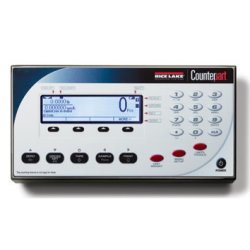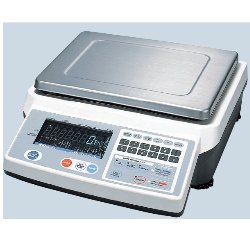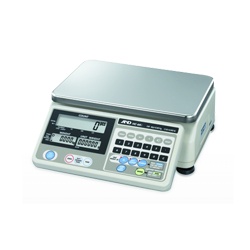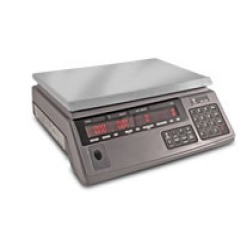HOW COUNTING SCALES WORK:
Digital Counting scales look at the weight of the parts you place on the weighing platform and divide the weight by the number of pieces you entered, to compute the average piece weight (APW). This is how a digital counting scale displays the number of pieces or parts. This page is here to help you understand how does a counting scale work?
How do you set a scale to count pieces?
The item(s) you are counting must be uniform in weight. No counting scale will ever work if there is a significant variation in the weight of the items. The larger the initial sample (100 pieces versus 5 pieces) the better results the counting scale can provide since it averages out any variations in the piece weights.
DON’T PURCHASE A COUNTING SCALE WITH TOO MUCH CAPACITY!!!
Many people buy a parts counting scale with more maximum capacity than they typically will be needing. FOR EXAMPLE: If 75% of the time you will be counting no more than 10 lbs of parts at a time, a 10 lb. capacity counting scale is the ideal choice as opposed to a 50 lb. capacity scale since you may be sacrificing resolution so you can have a larger capacity. Too many times, consumers see the large capacity and think they may need that in the future.
If you think you may need to weigh and count larger items in the future, just make sure you buy a counting scale with a remote scale option available or a counting scale with accumulation function. Remote Scale examples include the CAS EC2 and Intelligent IDC battery operated counting scales. Then when the time comes, you can add a bench scale platform or even a 4’x4’ floor scale to your counting scale.
Accumulation function allows you to add together counts for a total. Examples include the A&D HCi and the A&D FCi series scales.
Remember, we count each type of item separately. We can't just dump nuts and bolts on the scale together. Items that we're counting need to be the same weights. For example, if we were counting money, we would count quarters separately from nickels, etc... So, if we're counting bolts, we place (10) bolts on the scale and press Sample. We now have our average piece weight and can place the rest of our bolts on the scale. We remove the bolts and then repeat the same process for the nuts.
CAPACITY x READABILITY 100 x .005 lbs ????? What’s this? and Which Counting Scale should I buy?
Remember, the higher capacity, the lower the sensitivity for any counting scale. First, find a model that meets your capacity and accuracy requirements (remember the least amount of capacity you can handle is better). Capacity x Readability will most likely be listed as for example: 100 x 0.005 lbs. In this example, 100 is the max capacity or maximum amount of weight you can put on the scale, while, 0.005 is the "readability" of the scale, the amount that the scale increments up or down. One of the easiest ways we’ve found to determine what readability you need is as follows…
Look at the smallest readability increment of the counting scale you’re interested in and multiple this number by 5 P/N: 210675-00100 Model: GSE 675 Cap x Readability: 100 x .005 lbs .005 x 5 = 0.025 lbs RESULT: So, if you purchase this industrial counting scale, the lightest part you can comfortably expect to be able to count would be approximately 0.025 lbs each (or 11 grams each) Now that you’ve figured out what capacity and readability that you need, look at the features required for your applications (both now and in the future). Features include: computer/printer interfacing capability, battery operation, ability to connect a larger platform scale (remote scale), etc...
Now that I have my scale -- I’m having trouble counting!!!!!!
Many factors can be the culprit for a counting scale to display incorrect counts. Most of the factors are actually not a result of the scale being defective or out of calibration. A lot of times the problems are simple or believe it or not OPERATOR ERROR!
Below are some simple questions to ask yourself if you‘re having trouble with your counting scale:
1. Are any external sources causing the scale to give varying counts such as a fans blowing on the scale, vibrations or extreme temperature changes?
2. Is the scale level on all 4 corners? (look at the bubble level)
3. Since counting scales count by determining the average weight of the component being counted, it is important to use a sample size of at least 10-25 pieces. The larger the sample size used, the better overall count. Although all counting scales will let you use a sample of less than 25, we always recommend using at least 10-25 pieces as a sample.
4. Are all your operators using the same sample size? Are some using a sample of 5 while others are using 25 or 50 pieces? This can DEFINITELY cause your counts to vary!
We hope this helps you make an intelligent decision about which parts counting scale is best for your application. We strive to bring you only the best – most reliable – user friendly -- parts counting scales available.






We can give you some reviews on what products we believe would work the best for your application and who are the best counting scale manufacturers in the market today. We specialize in providing professional quality digital systems from A&D, Brecknell, Pennsylvania, Digi, GSE and Rice Lake -- many battery powered. Almost always in stock, easy to use, and always at great prices. We also do have a small selection of cheap counting scales available to satisfy those customers who are looking to compare our products to material handling catalogs and websites.
We'll leave you with one last note to consider (before you go and browse OUR SITE) to choose your next counting scale. In order to obtain accurate counting results, your initial sample count is crucial. Below are a couple of tips we recommend.
- Select sample pieces throughout the box. In other words, don't just grab the first ten machine screws at the top of the pile. Make sure you get a representative sample of the entire quantity of screws.
- Use a sample of at least 10 pieces. Make sure whoever is doing the sampling is not distracted by other workers or electronics such as cell phones.
- Key Point! Many scales offer enhanced average piece weight calculations. This can help you "fine tune" your sampling for increased accuracy without having to count out large amounts. For example, Rice Lake Counterpart offers this, see below.
Piece Weight Enhancement
After performing a sample process, the unit determines the maximum number of pieces that could be accurately used for a re-compute. If the number of pieces on the scale is less than the re-compute value, the RECOMP annunciator will be shown.
1. Place items to be counted on the scale platter; make sure the RECOMP annunciator is still on.
2. Press the SAMPLE key while the RECOMP annunciator is shown. This will start a sample process using the current piece count (instead of the SAMPLEQTY value) as the sample quantity.
- Finally, limit the external affects as much as possible. Operator error, slight breezes or drafts caused from something as simple as opening doors can impact the counting process.
